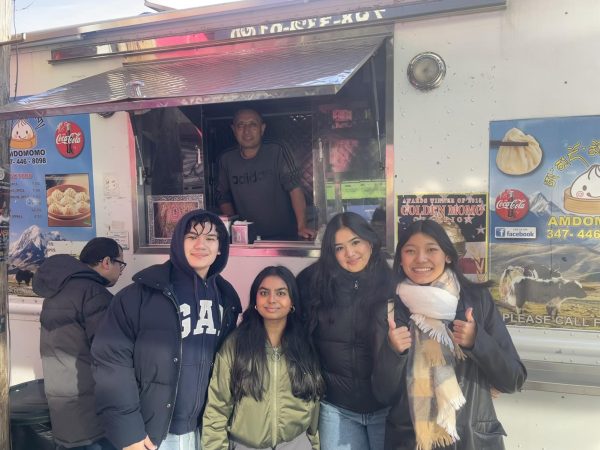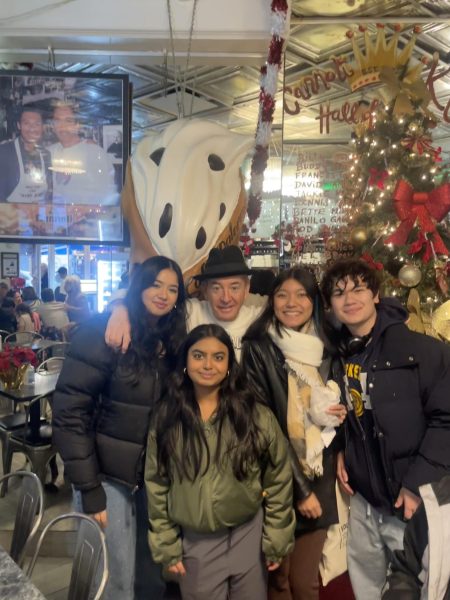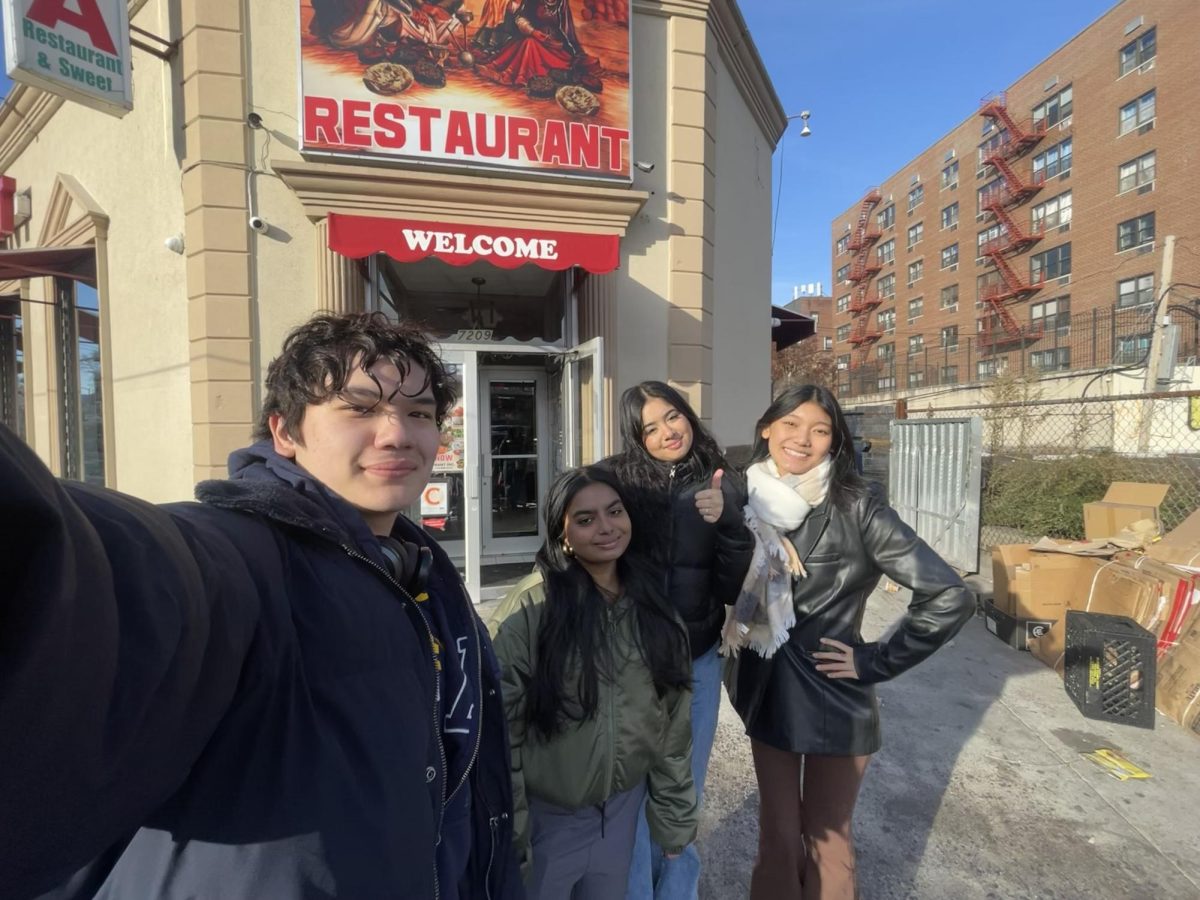New York City, nicknamed ‘The Big Apple,’ is famous for its extensively high skyscrapers, colorful Broadway shows, the MET Gala steps, and thousands of concerts held at Madison Square Garden. Tourists flock with wonder-stricken eyes to places like Times Square, but behind the glitz and glamor, most call this city “home” because of its rich and diverse culture.
Growing up in New York as a young Tibetan girl, I was always surrounded by cultural hotspots that made me feel endlessly welcomed. Without fail, when it was time for a holiday dinner or weekend lunch, my family would rush to grab a table at Spicy Tibet, a small family-owned Tibetan restaurant nestled between the Roosevelt train station and a Mexican bakery in Jackson Heights, Queens. I was curious to learn about other peoples’ equivalent of Spicy Tibet, so I took a few of my friends on a brief, but delicious, food crawl around the city to get a taste of the true beauty of New York City.
Opened by Muhammad Saif Ullah Nagra in 1971, Dera has become a staple in the Jackson Heights community. The moment that customers walk in, they are immersed in the culture of the restaurant, greeted by a massive painting of a family wearing traditional Indian clothing.
Dera offers a menu with a vast selection of food, serving Pakistani, Indian, Bangladeshi, and Nepali dishes, catering to a variety of palates. Dera additionally offers a plethora of vegetarian and vegan options. Unlike a lot of bigger franchises, the food at Dera is extremely affordable. After searching the menu, I ended up asking for two orders of Naan (bread) and Butter Chicken for $14, which generously also included a starter salad and Raita, a yogurt-based Indian side dish. The restaurant is also known for their Indian sweets. From Gulab Jamun to Laddoo, Dera serves dozens of desserts for as low as $3 each.
Surprisingly the most striking thing about Dera was not its delicious food, but rather its homely and comforting atmosphere. Filled with tables all just a few inches apart, it was common to see customers talking to each other, especially when the T.V. was on. Dera is known to hold televised sports events, attracting many people living in the neighborhood at night. Especially during the taping of cricket events, the waiters at Dera claim the restaurant becomes busier than ever.
One local Bronx Science student, Umme Anushka ’24, noted that Dera is her “dad’s second home on Friday nights.” Since immigrating here about ten years ago, her dad has built life-long friendships right at the tables of Dera. “There were no more seats left during a cricket match watching, and his friend, who was a total stranger at the time, just called him over to an empty seat next to him.” As Umme told me the story of her dad and his best friend meeting at Dera, the significance of the restaurant’s energy, beyond its menus, became starkly apparent.
Unlike the rest of the locations I covered, the Amdo Momo Food Truck isn’t an actual restaurant, but rather a food haven on wheels. Gaining its recognition from the 2015 Momo Crawl, a local momo competition, the truck has become one of the most famous food trucks in the Tibetan community. Thubten Amchok, the owner and chef, grew up in the Amdo region of Tibet but didn’t remain there for long. Amckok fled to Nepal, to India, and eventually to America in 1995. His food journey in America unfolded with nothing but a small dumpling pushcart.
If you visit Amchok’s truck, you’ll find yourself examining all the posters and memorabilia on the side of the truck: the certificate of his victory in the Momo Crawl, a picture of Mayor DeBlasio eating at the truck, and multiple indications of his cultural heritage, including flags and stickers of snowlions, an emblem of Tibet.
Whilst talking to Amchok, we learned how his momo’s great taste is derived from its simplicity. “Not many other ingredients are involved,” he said. And not many are needed in this $7 meal. The momos are composed of a layer of dough that is wrapped around the scrumptious meat and onion mix. The plate is served with a side of cold pickled radish, a perfect contrast to the juicy, steaming momos. With the exception of a few sauces available at the standing counter of the truck, the plate is void of anything else, giving the customers a simplistic, but fulfilling taste of Tibet.

Only one block away from Dera, the Asian presence around the Amdo Momo Food Truck is certainly a prevalent one, making it a clear representation of the community it sits in. The truck is located right on 74th Roosevelt, often referred to as Diversity Plaza. Knowing Amchok’s life journey of finding refuge in multiple countries, having experienced Tibet, Nepal, and India, plays a huge part in understanding the significance of the truck. Jackson Heights itself is made up of cultural backgrounds from those three specific countries, showing how Amchok found this familiar feeling and background reflected in his own journey, in the community he ended up settling in. And now, through the staple of his truck, he’s helping foster that community for the next coming generations, upholding this authentic, diverse setting.
The oldest Chinese restaurant in New York City, Nom Wah Tea Parlor still proudly stands on 13 Doyers Street in Manhattan’s Chinatown, hiding in a long alleyway off the Main Street. Nom Wah Tea Parlor takes the name of a “hidden restaurant” to a whole new level, as its location can only mean that it is either filled with locals, or people who just happened to bump into it. Starting in the 1940s, the business had always stayed within the family, passing from Ed and May Choy to their nephew, Wally Tang, in 1976.
It originally opened as a bakery/tea parlor, as hinted within the name itself. The original menu consisted of their green tea, almond cookies, and red bean filling, all of which are still best sellers at Nom Wah Tea Parlor. In addition to this, they’ve expanded their menu to include dim sum, noodles, and a variety of teas. I decided to try their green tea, along with an almond cookie and a pork bun, an order that helped me understand how this business had stayed in business for decades. The most noteworthy aspect of the parlor is the china they used for their green teas. In contrast to the plastic, red cups used for water and juice, all the tea are served with traditional china, reflecting the culture that Nom Wah Tea Parlor’s cuisine is modeled after. It was great to see that the Chinese culture that Nom Wah Tea Parlor originated from was kept alive after all the decades it spent in the middle of New York City.
Caffe Palermo (“Cannoli King”)
“I’ve been here since I was seventeen… I’m the Cannoli King!” Walking the streets of Little Italy in Manhattan, it’s hard not to notice Caffe Palermo, or as it’s better known as – Cannoli King. Nicknamed after the humble owner, Chef John DeLutro, Cannoli King has been standing since 1973. I happened to stop by during their 50th anniversary celebration, a truly magical time for the community in Little Italy. From the roads that were covered in rainbow paint, to the banners hanging from street lights that announced their 50th anniversary, it was clear to any visitor that Cannoli King held a huge presence in their community.
Walking in, their walls were decorated with all their successes, including their features on the Rachael Ray Show, eye-catching headlines from the articles published about them, and visits from celebrities like Danny DeVito and John Stamos. The place was packed to the brim, with a line going out the door and the tables filled to capacity. Surprisingly, while talking to some people on the line, we realized that most of these customers were regulars, rather than tourists. It seemed as though many locals viewed Cannoli King as a regular dessert joint for their families. The cannolis and gelato were their traditional holiday desserts.

Luckily, the Cannoli King himself was working as a cashier and helped me pick out what to get. He gave me the original cannoli, the dessert he first opened up with, a lava cake, and a complimentary scoop of gelato. When ordering from Cannoli King, you can definitely expect that you’re not only paying for the fresh food, but for the joyful experience with the great workers and lively background. The prices were definitely worth the bite.
Conclusion
In 17,000 steps, I covered four community-centered, cultural restaurants in New York City. The city is known to hold immigrants from all over the world, supporting one of the most diverse populations in the country. They find refuge within the neighborhoods – or better yet, the enjoyable aspects of those neighborhoods – that reflect the home they left behind. With the arrival into each new restaurant, I witnessed a new group of people that found home in the menus, the workers, and the space. Whether it’s through rooting for a cricket team or conversing at the side of a food truck, the best types of restaurants in New York City are those that help the customers find a sense of familiarity within it.
So, if you’re ever looking for a new food place to try out, I welcome you to head into one of these restaurants. I promise you, you’ll not only leave with a full stomach, but with a warm heart and a smile plastered to your face.
With the arrival into each new restaurant, I witnessed a new group of people that found home in the menus, the workers, and the space.

